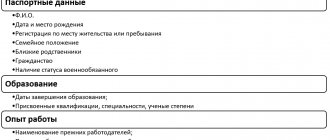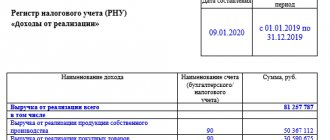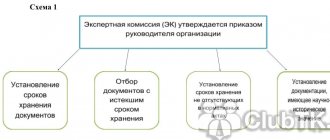How to properly store employee personal files
Given the laws on how to store the records of employees who are terminated, they should be stored in government agencies. Commercial organizations provide all archival information on their own, so if there is a need to confirm the length of service for a pension, all documents can be obtained from the archive.
A former employee has every right to demand the opportunity to obtain information contained in archival papers; no one can refuse him this.
What is a personal matter?
The personal file for any employee is presented in the form of a folder where the entire package of documents and information about the employee is collected. All positions held by the employee while working at the enterprise are indicated there. This set of documents is prepared individually for each employee. Taking into account Federal Law No. 79-FZ and Presidential Decree No. 609, all personal files for civil servants and other categories of workers can be processed at the request of the employer. As experience shows, every enterprise keeps records of personal files, as this helps to systematize the work of the personnel department and organizations.
What is a personal matter
This is a package of information and documents about the employee, his positions and promotion. It is mandatory that files be kept only for civil servants (see Federal Law No. 79-FZ of July 27, 2004, Presidential Decree No. 609 of May 30, 2005), how many and where personal files of employees are stored is determined at the legislative level. In relation to employees of other organizations, such documents are maintained according to the decision and desire of management. But if a decision is made to keep them, then the papers will have to be stored taking into account the regulations for state-owned companies.
How is an employee’s personal file prepared?
Let's consider how to register an employee's personal file. The personal file of an employee who has resigned must include a dossier and be stored in the HR department until the end of the year. Further, for three years after dismissal, all documents must undergo technical processing and be transferred to the archive for further storage. After transferring the folder to the archive, there are still some aspects that are worth doing:
- The case must be stitched or bound.
- Storage with buttons and paper clips is not allowed, so they must be removed first. The case is bound and packaged in a hard cover. This is done so that the papers are better preserved and are not subject to fraying.
- All personal documents must be enclosed in an envelope, which is then filed and numbered. All attachments and applications that are made are numbered one by one. This includes: military ID, work record, diploma, identity card and other documents that are important.
- At the end of the case, a blank sheet is filed and a certified sheet is drawn up; it is not included in the total number of sheets that are in the folder. Such sheets must be filled out in accordance with regulations; all the information they contain is very important, since the entire list of documents and the storage date are indicated there.
This is also important to know:
Deadlines for payment of vacation pay according to the law, calculation of compensation
Particular attention is paid to documents that are inside the folder. They must be arranged chronologically. That is, everything must go from the first document to the last in order, so it turns out that the earliest document will be the very first, for example, it could be an employee’s written permission to process his data, and the last document, accordingly, will be the dismissal order itself.
Sample design
According to order No. 609, which was issued by the president on May 30, 2005, every enterprise must collect data about employees. The following documents are required:
- Questionnaire, resume and characteristics, a sheet for the HR department is also included separately.
- The employee must present copies of the passport, educational documents, TIN, insurance certificate and documents indicating marital status. Documents that contain personal information about a person, for example, such as his marital status, may not be presented by the employee; this is done at his own discretion. Sometimes this information may somehow affect political or religious views, which is an infringement of rights, therefore these documents can only be accepted with the consent of the employee.
- Certification information.
- Contract or employment agreement.
- Employer orders related to transfer to another position or place of work, leave orders.
Compound
A file, or a set of documents enclosed in a separate cover, is maintained for each employee of the enterprise. What documents need to be collected for employees, in what form to systematize them and how to store employees’ personal files in the organization is determined by the employer. Typically this includes:
- questionnaire;
- application for employment (for employees of commercial enterprises this is an optional document, but for civil servants it is mandatory to write it in accordance with paragraph 2 of Article 26 of Federal Law No. 79-FZ of July 27, 2004);
- copies of passports, diplomas, military IDs, etc.
For civil servants, the list of contents of the case is regulated by clause 16 of the Regulations, approved by Decree of the President of the Russian Federation No. 609 of May 30, 2005.
All documents that are filed in files are recorded according to the internal inventory.
Sample inventory
What documents should be included in personal files?
The composition of each personal file and the formation procedure for entrepreneurs are not fixed in the laws, but a clause must be present in the local act of the company. All documents that can be classified as personal files can be divided into several groups:
- Primary documentation that is drawn up when a person starts working. These documents include those that are submitted by an employee when he gets a job, for example, a resume, documents on education and qualifications, photocopies of a passport, SNILS, IIN, recommendations from former employers, if of course they are available, military registration documents, a certificate of no criminal record, medical examination, employment application, copy of the order, employment contract.
- The second group includes all the papers that appear during the work process. They indicate the employee’s professional achievements and career growth. Such papers usually include the following:
- certificates that indicate advanced training;
- driver's license;
- certificate of marriage or divorce, birth of children;
- job descriptions, if additional agreements were concluded, then they are included;
- agreement on liability;
- certification acts;
- photocopies of orders that indicate an internal change in a person’s position, for example, when an employee is transferred to another job;
- disciplinary sanctions and rewards;
- application for leave.
This is also important to know:
How to restore a work book if it is lost
The next group of documents is drawn up only when the employment relationship with the employer is terminated. Considering that the production business ceases to exist, it should be completed properly. The last documents in the folder should be:
- resignation letter;
- photocopy of the dismissal order;
- documents on dismissal if an external transfer was made;
- death certificate of the employee, if the employee died.
What it is?
A personal file means a set of documents and information about a specific employee and his work activity, systematized in a certain order. In general, a personal file is a folder in which all documents related to a specific employee are placed.
Important! Private organizations, including individual entrepreneurs, are not required to maintain personal files of employees, since the law does not contain such a requirement.
The exception is government employees. In the case of them, maintaining personal files is mandatory (Federal Law No. 79-FZ dated April 27, 2004 and Decree of the President of the Russian Federation dated May 30, 2005 No. 609).
Due to the fact that maintaining personal files is a voluntary decision of the employer, the procedure for creating and using such databases is not regulated at the legislative level.
For this reason, some organizations independently develop internal regulations that establish rules for working with such information.
All documents stored in the employee’s personal file constitute his personal information. The protection of this data is guaranteed by law (Federal Law “On Personal Data” dated July 27, 2006 N 152-FZ). Also, information from a personal file cannot be transferred to third parties except in cases specifically established by law (for example, at the request of a court).
Access to the data is limited to a limited number of specially authorized persons (for example, the head of the organization or the head of the personnel department). Access must be secured in the relevant local acts of the organization. And of course, the employee himself can freely obtain any information from his personal file upon request at any time.
All materials included in an employee’s personal file can be divided into three groups:
- Documents that appear upon hiring, including various additional certificates.
This group may include:
- application for a job,
- employment contract,
- personal card (form No. T-2),
- order for admission to a specific position,
- copy of the passport,
- SNILS, INN, etc.
- Documents drawn up in the course of employment.
The following types of papers can be included in this section:
- additional agreements concluded to the employment contract,
- certification sheets,
- orders for promotion, etc.
- Documents that are drawn up in case of dismissal of an employee.
These, for example, include:
- resignation letter of one's own free will,
- dismissal order.
In relation to employees for whom maintaining personal files is mandatory, the list of documents is established by the relevant regulations.
In general, although the creation of personnel files is not a mandatory requirement, many organizations still maintain them. This allows you to quickly find all the necessary information about the employee you are interested in.
Personal files and positions of employees
As a rule, personnel documentation is created for deputy managers at various levels. Also included in this category are key specialists, employees who are responsible financially and the personnel reserve.
It is important to take into account that it is necessary to create personal files for such employees, regardless of whether they work part-time or on a permanent basis, under a fixed-term contract or at their main job. Most often, no documentation is kept if a person occupies a position that does not require advanced training, for example, a cleaner or a janitor.
Free legal consultation
Free legal consultation We will answer your question in 5 minutes!
Ask a Question
We will answer your question in 5 minutes!
Ask a Question
Who do they file personal files against?
This question can be answered unequivocally only in relation to civil servants: for all, as required by law.
Since maintaining personal files is not necessary for private entrepreneurs, they themselves can decide which employees to keep this documentation for, and which ones can do without such detailed personnel records. Some managers who practice this system prefer to keep personal records for all personnel in order to systematize data for each employee. But some, in order to save time, organize the management of personal files only for certain categories of employees.
This is also important to know:
Article 77 of the Labor Code upon dismissal: grounds for terminating an employment contract
Personal files are usually opened for employees of what positions:
- management;
- deputy managers at various levels;
- key specialists;
- employees bearing financial responsibility;
- personnel reserve, etc.
FOR YOUR INFORMATION! It is advisable to open a personal file for such employees, regardless of the form and time of his employment - he works part-time or at his main job, under a fixed-term employment contract or on a permanent basis.
Less often, positions are provided with personal records for which educational, qualification or other special requirements are not provided, for example, cleaner, watchman, janitor, etc.
What is the procedure for maintaining documents?
A personal file is a collection of all documents that are related to one employee and contains information about his work activity and length of service. All budgetary organizations maintain such documentation, but sometimes selective maintenance occurs, for example, personnel records, which apply to management personnel and persons who are financially responsible. Registration of personal files of dismissed persons implies the following points:
- The need to make records of all changes that occur to the employee;
- Attachment of all materials related to the service and their withdrawal;
- Issuance of materials and certification of copies;
- Maintaining an internal inventory;
- Periodic checking of the status of documentation;
- Closing and transferring to the archive for further storage.
It is important to remember that maintaining documents that are included in a personal file must be approved by a local act.
Composition and procedure for creating personal files
As a rule, a personal file is created within 7 days after the employee is hired. To do this, create a separate folder for it. Its cover acts as the title page. Fill out, for example, according to the form from Appendix No. 28 to the order of the Ministry of Culture of Russia dated March 31, 2015 No. 526.
In addition, on the cover in the middle of the sheet you can indicate:
- FULL NAME. employee;
- his date of birth;
- start date of personal file management;
- date of employment with the company;
- personal file registration number.
IMPORTANT!
A personal file can be created not only in traditional paper form, but also in the form of an electronic archive of copies of all documents. It is stored on a company server protected from unauthorized access.
To make entries, use a black, blue or purple pen. All corrections are certified by the signature of the employee responsible for maintaining personal files.
The following list of documents is filed in the folder:
- Autobiography (if available) or application form completed as an applicant prior to hiring.
- Copy of the passport.
- Copy of military ID.
- Copy of TIN.
- Information about SNILS.
- Copies of education documents.
- Employee's photo.
- Applications for hiring and dismissal, transfer to another position.
- Copies of orders on admission, dismissal, personnel transfer.
- A copy of the employment contract.
- Certification sheets.
- Notification of the possibility of switching to an electronic work record book and an employee statement on this issue.
- Characteristics and letters of recommendation.
- Copies of documents on incentives and awards.
- Other documents about work activity.
IMPORTANT!
It is prohibited to request documents other than those specified in Art. 65 Labor Code of the Russian Federation. Therefore, if the personal file includes a wider list of documents, the possibility of their provision by the employee should be provided for in the local acts of the organization.
Personal files are numbered in order. At the same time, the numbers assigned to the folders of already dismissed employees are no longer used.
Each case is recorded in a special journal. In addition, the assembled folder must include an internal inventory of the documents included in it.
Responsibility
A list of employees who can deal with personal matters must be compiled by the organization’s leaders and the corresponding order is issued to them. Each employee has every right to get acquainted with the information that concerns him from the personnel officer.
Third parties cannot have any relation to such information, because this will already be considered a violation of the legislation of the Russian Federation. The laws provide for liability under Art. 81 and art. 192 Labor Code of the Russian Federation, art. 243 Labor Code of the Russian Federation, art. 13.11 and 13.14 Code of Administrative Offenses of the Russian Federation, Art. 137 and 140 of the Criminal Code of the Russian Federation.
Sample inventory
Access to personal data It is important to remember that working with personal data without the written consent of the employee, if these actions do not contain criminal offenses, entails a fine (Part 2 of Article 13.11 of the Code of Administrative Offenses of the Russian Federation):
- Business name;
- serial number;
- structural subdivision;
- Full name of the employee;
- day of establishment of the case;
- document closure date - based on the dismissal order;
- the number of sheets filed - it is advisable to enter at the time of submission to the archive;
- folder storage period.
How a personal file is formed after an employee has been fired
The personal file must be closed on the day the employee quits. After this, an authorized specialist carries out the following manipulations:
- Checks that all documents are available.
- Checks the chronology of documents in a folder.
- Verifies the numbering of sheets.
This is also important to know:
The procedure for engaging in overtime work: sample order, calculation and payment for irregular working days
A final entry must be made on the internal inventory. It contains the number of sheets that make up the personal file, the number of inventory sheets. The compiler must sign and make a final entry, after which a certification sheet is drawn up, which describes the personal file. All papers are stitched together; at the beginning there will be an inventory sheet, and at the end there will be a certification sheet. The cover page must contain the closing date, which must correspond to the dismissal order and the retention period for the folder.
It is important to note that if the dismissed employee did not pick up the original documents, then they should be kept until he applies for them. All documents are placed in envelopes, each placed separately, and filed in a folder. Envelopes are numbered, sealed and signed.
Access to documents
Each personal file includes personal data about a person, so there is a need to ensure their protection. The employer must limit the list of persons who have access to such documents and create a corresponding order for the organization. Persons who have received such access have no right to disclose data without the consent of the subject; this is clearly stated in federal law.
The manager, by order, appoints a person who will be considered responsible for this type of documentation and its storage. The list of those who have access to information may include:
- The head of the organization and his deputies.
- Head and employees of the HR department.
- Managers and employees of the legal service.
- Accounting employees who calculate salaries and make contributions to the tax office.
- Heads of structural divisions.
Third-party organizations may gain access to personal files, but only if a written request is made and the head of the organization gives his consent.
Who has access to personal files
All cases contain personal data (PD), and compliance with the requirements for their protection is the direct responsibility of employers (Chapter 14 of the Labor Code of the Russian Federation, Federal Law No. 152 of June 27, 2006). The list of persons with access to personal data is approved by order of the head. At the same time, persons who have access to PD are obliged not to disclose to third parties or distribute this data without the consent of the PD subject, unless otherwise provided by federal law.
This is also important to know:
Dismissal of the director of an LLC at his own request: registration
The head of the organization, by order, appoints those responsible for maintaining and storing personal records (usually the head of the personnel department and his subordinates), and also approves the list of persons who have access to them (this information can also be fixed in the Instructions for maintaining personal files). This list usually includes:
- the head of the organization and his staff deputies;
- head and employees of the HR department;
- head and employees of the legal service;
- accounting employees who calculate wages and make tax and other deductions;
- heads of structural units (in relation to subordinate employees);
- other responsible employees approved by order.
Representatives of third-party organizations can access LD only with the permission of the head of the organization upon an official written request.
Sample order for admission
How are files stored in the HR department?
The HR department should only store documents of those employees who are working. They are placed in a special place to which third parties cannot have access, this eliminates the possibility of their loss or theft. As a rule, special safes that are locked with a key are used for storage. All documents are located in a vertical position under a serial number and in alphabetical order. The repository should also contain a list of all personal files.
A separate logbook is kept. As for the general form, it has not been approved, so each organization can develop it independently. According to all the rules, at the end of the working day the presence of papers in the safe must be checked. In case of loss, measures must be taken immediately to return them to their place.
How long are folders with papers of dismissed employees kept?
When asked how long the personal files of dismissed employees are kept, the answer is simple. It is worth considering that these papers have a long shelf life, so those documents that were created in 2003 will be stored for 50 years, previously this period was 75 years. In order for everything to be correct, upon dismissal, all papers are reconciled, the inventory is closed and at the end a certification sheet is inserted, which is stitched onto all 4 protocols.
This is also important to know:
How to restore a work book if it is lost
The case is transferred to the archive after three years since it was closed. The personal files of dismissed employees should be stored separately from existing ones. Almost every organization has an archival storage facility where documents are moved. If there is no such room, then all papers can be placed on a separate shelf.
Retention period for personal files of dismissed employees
The question often arises, how long are the personal files of dismissed employees kept? LD are long-term storage documents (cases opened after 2003 are stored for 50 years; earlier - 75 years (Article 22.1 of the Federal Law of October 22, 2004 No. 125)), therefore, in the event of an employee’s dismissal, they are subject to careful verification and closure. To do this, all documents in the case are verified, the inventory is closed, a certification sheet is inserted at the end of the case, and then the case is stitched with 4 punctures. How long to keep personal files of dismissed employees?
Archiving of personal files of dismissed employees occurs three years after its closure (for municipal and civil servants this period is 10 years). The records of dismissed employees must be kept separately from the records of existing employees. If the organization has a room for storing archival files, then they are temporarily moved there. If there is no specially equipped room, then they are located either on a separate shelf in the storage room or in another safe.
How is archival information used?
There are certain rules that apply to archival information. They are established by current legislation and office practice:
- Organizations and individuals must retain data about employees who were previously employees for certain periods, all of which are prescribed by law.
- Citizens can submit requests to obtain information from the archive.
- Copies and certificates related to social and pension issues regarding the receipt of benefits are issued free of charge.
- Today, archived data can be transmitted electronically.
How to store documents
Free legal consultation We will answer your question in 5 minutes!
Call: 8 800 511-39-66
Regulatory acts may not indicate the composition of documents in a personal file. There is a strictly regulated list for civil service employees. Each enterprise can freely use such a list in its work. Basically it all depends on the direction of activity. Each file must contain the following copies:
Free legal consultation
We will answer your question in 5 minutes!
Ask a Question
- Passport showing all completed pages.
- Diploma and additional papers that are issued for advanced training or certification of an employee.
- SNILS and INN.
- Military ID for men.
- Employment history.
Additionally, the case may include the following documents:
- Certificates from a medical examination and no criminal record.
- Specialist application for employment.
- Autobiography and employment contract.
- Certification documentation.
- Photos.
If necessary, this list can be adjusted. It is important to remember that information about an employee’s personal life can only be included if he has given his consent.
Document storage
At the level of regulations, the required composition of documents in a personal file is not indicated.
This is also important to know:
Dismissal of a single mother: who falls under the preferential category?
A strictly approved list is regulated only for employees of public services.
Each enterprise can use this list in its work, and depending on the direction of the enterprise’s activity, determine the need to include a particular document in its personal file.
List of required copies of documents:
- passport (page with photo, registration, marital status);
- diploma, certificate of advanced training;
- SNILS, INN;
- military ID;
- employment history.
Also involved in the matter:
- certificates of passing a medical examination and no criminal record;
- a specialist’s personal application for employment;
- autobiography, employment contract;
- documentation of past certification;
- photographs of workers.
If necessary, the list is subject to adjustment.
Without the personal consent of the employee, it is prohibited to include information about the worker’s personal life, his religious and political views.
Accounting and data recording
The accounting procedure must be carried out in accordance with the regulatory act in the labor sphere. Naturally, all changes must be registered in the personnel department and in a certain order. To make it convenient to keep such records, create a special journal. At the time of registration, the following data can be entered: registration number, full name of the employee, date of registration, note of deregistration.
The moment of registration is the date of recording in the registration book. In office work, it is possible to make changes to folders with personal files. Such changes must be recorded at the time of marriage, change of place of residence and upon transfer to another place of work.
In order for changes to be made, the employee must contact the personnel department himself, after which the head of the archive gives the command to enter the data. Data entry should follow the following algorithm:
- The employee must write a statement requesting changes to the documentation. Data can be entered under certain circumstances and their actual confirmation.
- Next, an order is issued that innovations must be included in the accounting documentation.
- The order is recorded in the journal.
- All information is recorded directly.
This is also important to know:
Payroll sheet - sample
Thus, we can conclude that the registration of documents, their storage and disposal of personal data are regulated by law.
Electronic papers
Today, many companies have implemented HR automation in their work. All employee data is stored electronically on computers. Paper documents are also not excluded, but this is more suitable as reinsurance. I must say that this type of documentation is very convenient. The search is also performed automatically, which reduces the time spent on searching. It is important to remember that you can maintain documentation electronically, but this does not apply to work books. There are also documents where the employee must put his personal signature, then in addition to the electronic form, the paper version must also be saved.
Electronic personal file
Nowadays, many Russian companies have implemented or have begun to implement HR automation. It can hardly be called following fashion, rather a necessity. Employees' personal files are increasingly maintained and stored in computer databases. Paper documents are used, but mostly as reinsurance.
Free legal consultation
We will answer your question in 5 minutes!
Free legal consultation We will answer your question in 5 minutes!
Call: 8 800 511-39-66
Ask a Question
This is also important to know:
How to fire an employee without his desire: what the law says
Maintaining and storing personal files in electronic form is, above all, convenient. A HR employee does not need to bite the dust, shifting things around in order to find what he needs. Therefore, one of the absolute advantages of electronic files is the ability to find everything quickly, without wasting time and effort.
It is worth noting that not all documentation can be kept in electronic form; work books, for example, cannot.
If the document must contain the personal signature of the employee, it must also be in paper form.
Additional questions
Can the shelf life of employees be reduced?
The storage period for the personal files of dismissed employees is 50 years. In this case, all changes must be taken into account and entered into folders. There is a special certification sheet, which is located at the end and an inventory sheet at the beginning. The title page indicates the closing date of the case and the period of its storage.
If the employee left original documents, then each such document is placed in a separate envelope and also attached to the file. Each envelope has its own numbering, which is also very important for proper paperwork.
What to do with the files of employees who have been fired
How is the personal files of dismissed employees properly archived? If a person quits, then his file is retrieved and filed. A certification sheet is drawn up, which contains all the information about the number of sheets and numbering. Data on damaged documents can be entered into this sheet if new ones were attached instead. The certification sheet is glued to the inside of the cover, and the HR employee must sign it. On the last day of his work, the employee has the right to ask for copies of all necessary papers.
conclusions
When dismissing an employee, there are certain rules that must be followed:
- The case must be closed on the day the employment relationship was terminated.
- The employee's file must be transferred to the archive three years after its completion.
- The personnel officer is responsible for storage.
Documents of dismissed employees (all folders and papers) must be stored in a separate room that is inaccessible to third parties. All papers are placed in a safe to prevent loss or theft. A former employee has the right to send a request to the company to provide him with all documents. If the organization has already gotten rid of them by that time, then the manager will be punished under Art. 13.20 Code of Administrative Offenses of the Russian Federation.
Subscribe to the latest news






